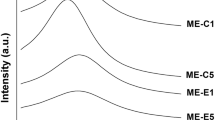Abstract
Purpose. The purpose of this work was to analyse the mechanism of the enhancement of percutaneous penetration demonstrated by the known enhancers Azone® and Transcutol®.
Methods. Enhancer induced changes in the diffusivity and solubility of a model permeant (4-cyanophenol) in human stratum corneum were monitored (in-vitro) using Attenuated total reflectance Fourier transform infra-red (ATR-FTIR) spectroscopy and compared to the gross effects of the enhancers on flux as measured using simple Franz-type diffusion cells.
Results. It has been shown by both the well-established Franz diffusion cell technique and the use of ATR-FTIR spectroscopy that the enhancers studied both increase the flux of cyanophenol across human skin in-vitro by a factor of approximately two. Furthermore, it has been demonstrated by ATR-FTIR that these enhancers are likely to exert their effects by different mechanisms. It is probable that Azone reduces the diffusional resistance of the stratum corneum and that Transcutol increases the solubility of the penetrant in this barrier.
Conclusions. There is increasing interest in the apparently synergistic nature in which certain enhancers appear to work. The exact nature of these multiplicative and/or additive effects is not known although there are numerous suggestions in the current literature. The application of ATR-FTIR spectroscopy to such enhancing systems will allow the mechanisms of the observed enhancements to be probed in greater depth.
Similar content being viewed by others
REFERENCES
B. Barry. Mode of action of penetration enhancers in human skin. J. Cont. Rel. 6:85–97 (1987).
J. C. Beastall, J. Hadgraft and C. Washington. Mechanism of action of Azone as a percutaneous penetration enhancer: lipid bilayer fluidity and transition temperature effects. Int. J. Pharm. 43:207–213 (1988).
D. Lewis and J. Hadgraft. Mixed monolayers of dipalmitoyl phosphatidyl-choline with Azone or oleic acid at the air/water interface. Int. J. Pharm. 65:211–218 (1990).
J. A. Bouwstra and J. Brussee. Effect of n-alkyl-azocycloheptan-2-one including azone on the thermal behaviour of human stratum corneum. Int. J. Pharm. 52:47–54 (1989).
A. C. Watkinson, J. Hadgraft, and A. Bye. Aspects of the transdermal delivery of prostaglandins. Int. J. Pharm. 74:229–236 (1991).
J. Rojas, F. Falson, G. Courraze, A. Francis, and F. Puisieux. Optimization of binary and ternary solvent systems in the percutaneous absorption of morphine base. STP Pharma Sciences 1:70–75 (1991).
A. C. Williams, N. A. Megrab, and B. W. Barry. Permeation of oestradiol through human epidermal and silastic membranes from saturated transcutol/water systems. In K. R. Brain, K. A. Walters and V. J. James (eds.), Prediction of Percutaneous Penetration, STS Publishing, Cardiff, 1995, Volume 4a, C43.
A. C. Watkinson. PhD Thesis, University of Wales (1991).
A. Göpferich and G. Lee. Measurement of drug diffusivity in stratum corneum membranes and a polyacrylate matrix. Int. J. Pharm. 71:245–253 (1991).
D. E. Wurster, V. Buraphacheep, and J. M. Patel. The determination of diffusion coefficients in semisolids by Fourier transform infrared (FT-IR) spectroscopy. Pharm. Res. 10:616–620 (1993).
R. O. Potts, L. Doh, S. Venkatraman, and K. C. Farinas. Characterisation of solute diffusion in a polymer using ATR-FTIR spectroscopy Macromolecules 27:5220–5222 (1994).
A. M Tralhão, A. C. Watkinson, K. R. Brain, J. Hadgraft, and N. A. Armstrong. Use of ATR-FTIR spectroscopy to study the diffusion of ethanol through glycerogelatin films. Pharm. Res. 12:1–4 (1995).
A. C Watkinson, J. Hadgraft, K. A. Walters, and K. R. Brain. Measurement of diffusional parameters in membranes using ATR-FTIR spectroscopy. Int. J. Cos. Sci. 16:199–210 (1994a).
A. C. Watkinson, K. R. Brain, and Hadgraft, J. The deconvolution of diffusion and partition coefficients in permeability studies. In Proceedings of the 21st International Symposium on Controlled Release of Bioactive Materials, p160–161, Nice, France (1994b).
J. Crank. The Mathematics of Diffusion, Oxford University Press, London, 1956, pp 42–61.
O. Diéz-Sales, A. Copovi, V. G. Casabo, and M. Herraez. A modelistic approach showing the importance of the stagnant aqueous layers in in-vitro diffusion studies and in in-vitro/in-vivo correlations. Int. J. Pharm. 77:1–11 (1991).
H. E. Boddé, M. Ponec, A. P. IJzerman, A. J. Hoogstraate, M. A. I. Salomons, and J. A. Bouwstra. In vitro analysis of QSAR in wanted and unwanted effects of azacycloheptanones as transdermal penetration enhancers. In K. A. Walters and J. Hadgraft (eds.), Pharmaceutical Penetration Enhancement,, Marcel Dekker, New York, 1993, pp199–214.
F. Schückler and G. Lee. Relating the concentration-dependent action of Azone and dodecyl-L-pyroglutamate on the structure of excised human stratum corneum to changes in drug diffusivity, partition coefficient and flux. Int. J. Pharm. 80:81–89 (1992).
R. L. Bronaugh and S. W. Collier. Preparation of human and animal skin. In R. L. Bronaugh and H. I. Maibach (eds.), In-vitro percutaneous absorption: principles, fundamentals and applications., CRC Press, Bocarton, 1991, pp 1–6.
A. Berthod, Y. Han, and D. Armstrong. Centrifugal partitioning chromatography V. Octanol-water partition coefficients-direct and indirect determination. J. Liq. Chrom. 11:1441–1456 (1988).
A. C. Williams, P. A. Cornwell, and B. W. Barry. On the non-Gaussian distribution of human skin permeabilities. Int. J. Pharm. 86:69–77 (1992).
R. O. Potts and R. H. Guy. Drug transport across the skin and the attainment of steady-state fluxes. In Proceedings of the 21st International Symposium on Controlled Release of Bioactive Materials, p162–163, Nice, France (1994).
W. A. Ritchel, R. Panchagnula, K. Stemmer, and M. Ashraf. Development of an intracutaneous depot for drugs. Binding, drug accumulation and retention studies and mechanism of depot. Skin Pharmacol. 4:235–245 (1991).
P. K. Wotton, B. Mollgaard, J. Hadgraft, and A. Hoelgaard. Vehicle effect in topical drug delivery III. Effect of Azone on the cutaneous permeation of metronidazole and propylene glycol. Int. J. Pharm. 24:19–26 (1985).
E. Touitou, F. Levi-Schaffer, N. Shaco-Ezra, R. Ben-Yossef, and B. Fabin. Enhanced permeation of theophylline through the skin and its effects fibroblast proliferation. Int. J. Pharm. 70:159–166 (1991).
Author information
Authors and Affiliations
Rights and permissions
About this article
Cite this article
Harrison, J.E., Watkinson, A.C., Green, D.M. et al. The Relative Effect of Azone® and Transcutol® on Permeant Diffusivity and Solubility in Human Stratum Corneum. Pharm Res 13, 542–546 (1996). https://doi.org/10.1023/A:1016037803128
Issue Date:
DOI: https://doi.org/10.1023/A:1016037803128




